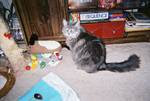Please remember to be cautious when decorating this Holiday Season! Our pets are curious...and sometime too curious and playful for their own good!
Here are some of our personal accounts...
"When one of my cats was about 6 months old it climbed up into the Christmas Tree to play with dangling ornaments. It made its way about 2/3 up the tree then out to the end of a branch and tipped the tree completely over! Needless to say, the kitten had a field day with all the ornaments lying on the floor!"
-- Janeen
"Coors (the cat featured above) may look innocent in this picture, but one year he ate multiple pine needles that bunched up in his stomach causing vomiting, pancreatitis, and secondary liver disease. It took Dr. Preston and I 8 weeks to get make our own cat well again...now we have a fake tree!"
-- Dr. Nell
"I'll never forget the year Pimpy, our Jardines Parrot, was accidentally left unattended. He took the liberty of opening (shredding) all of the wrapped gifts under the tree"
-- Dr. Preston
Remember to visit Lombard Animal Hospital for safe and nutritious stocking stuffers this year!
We will be featuring our favorites all month long on Facebook!
|







